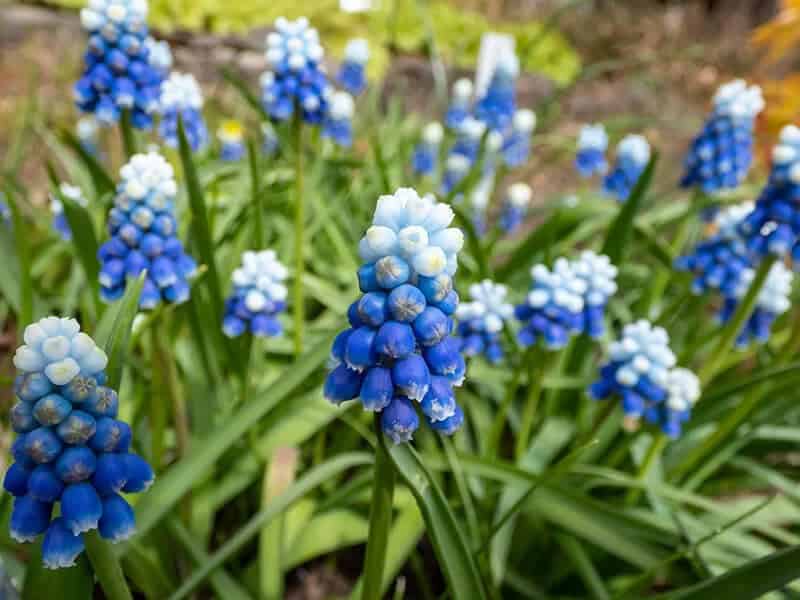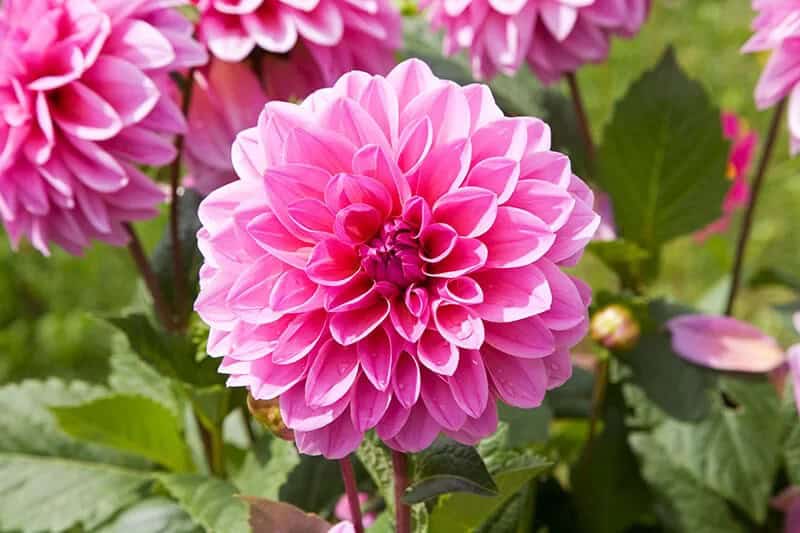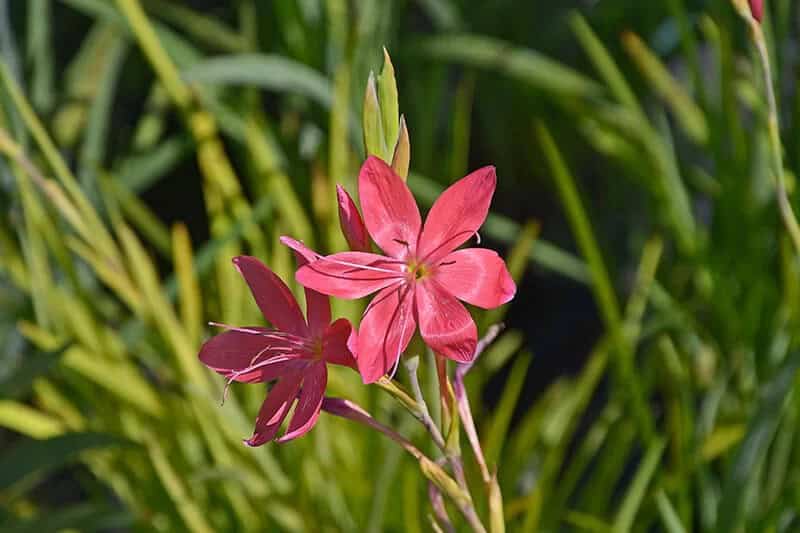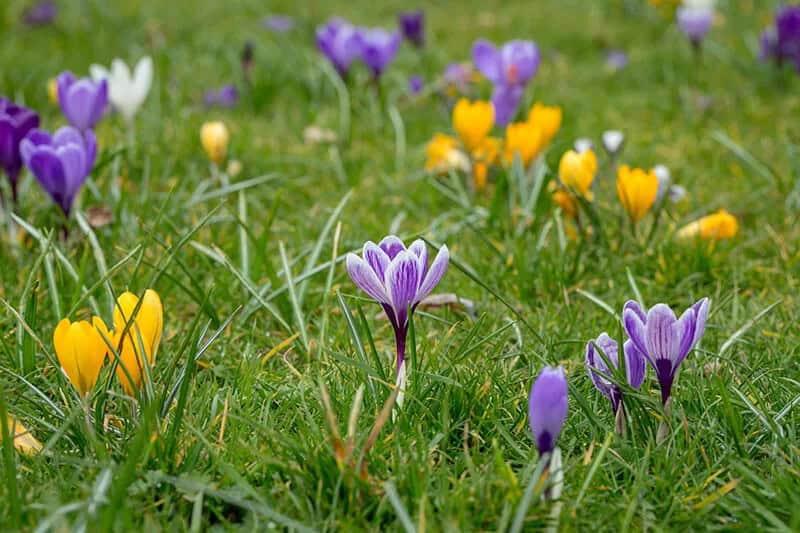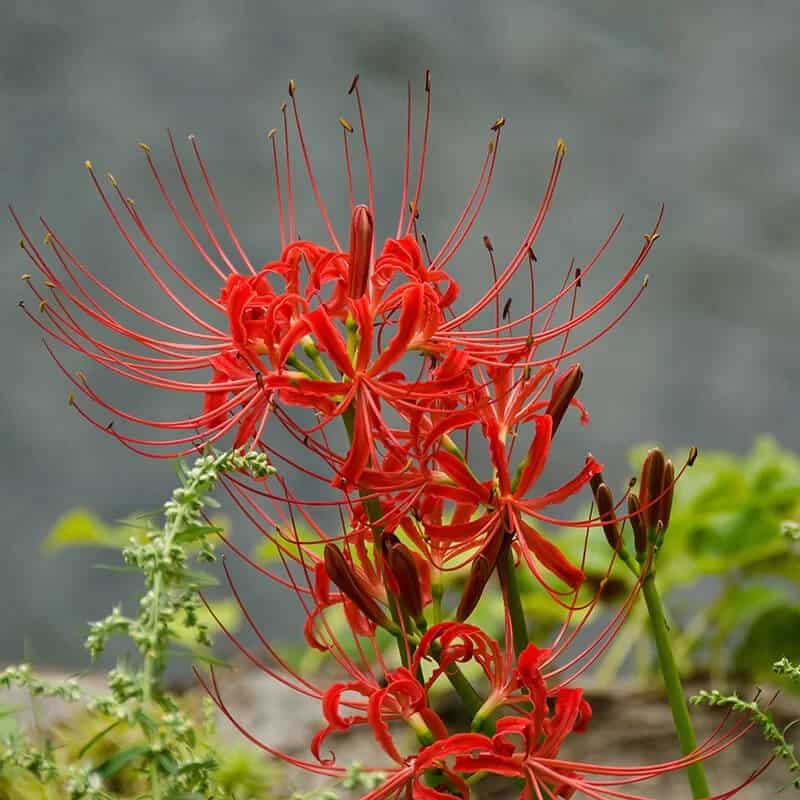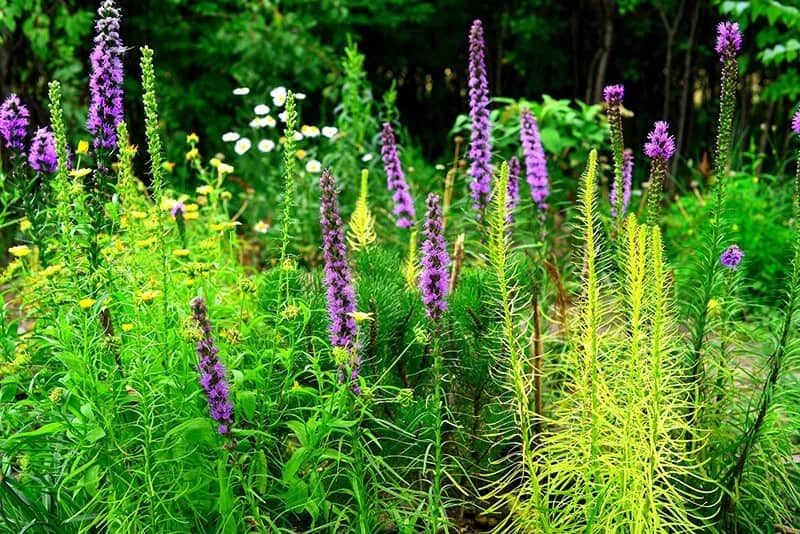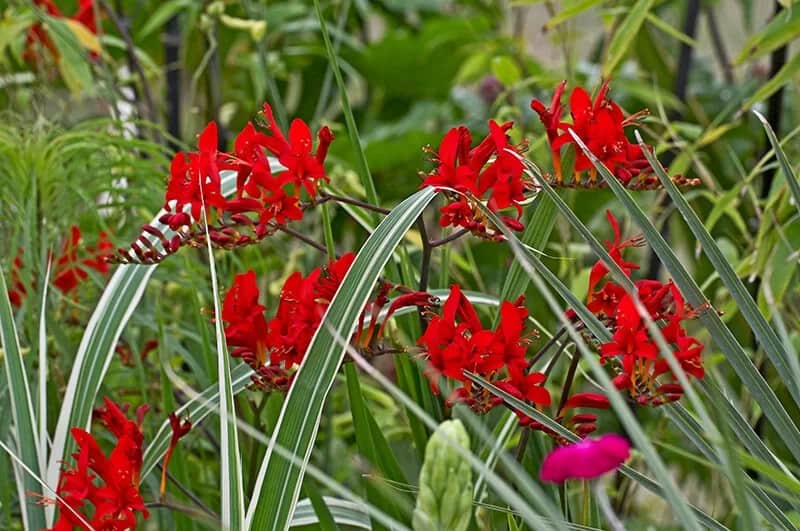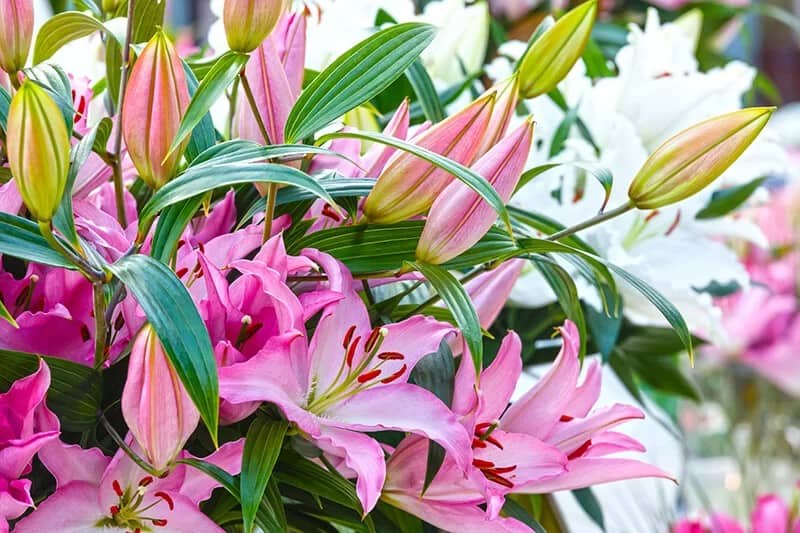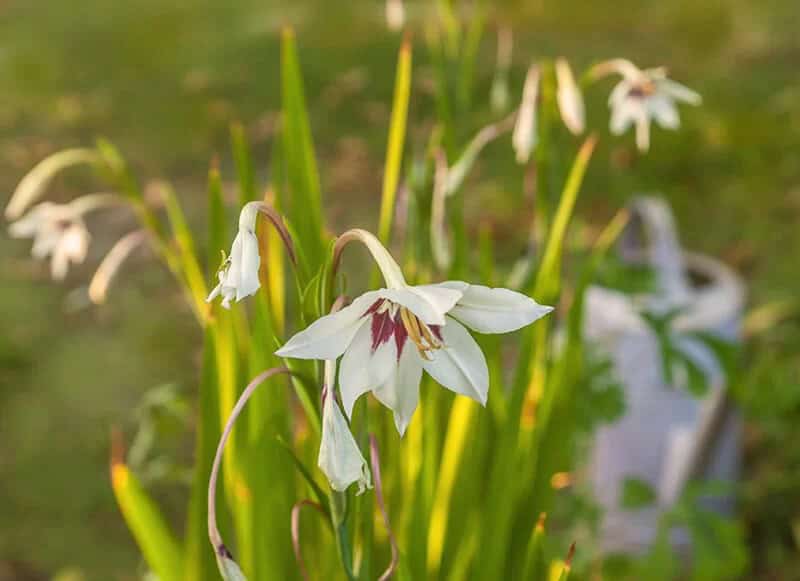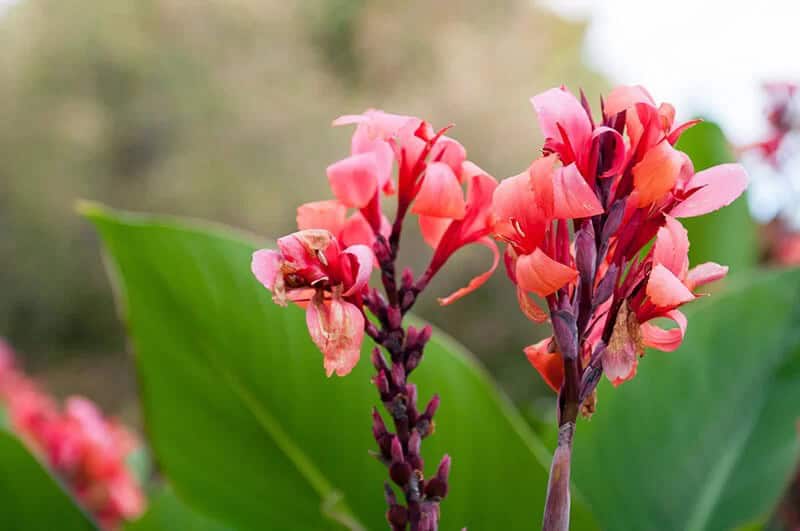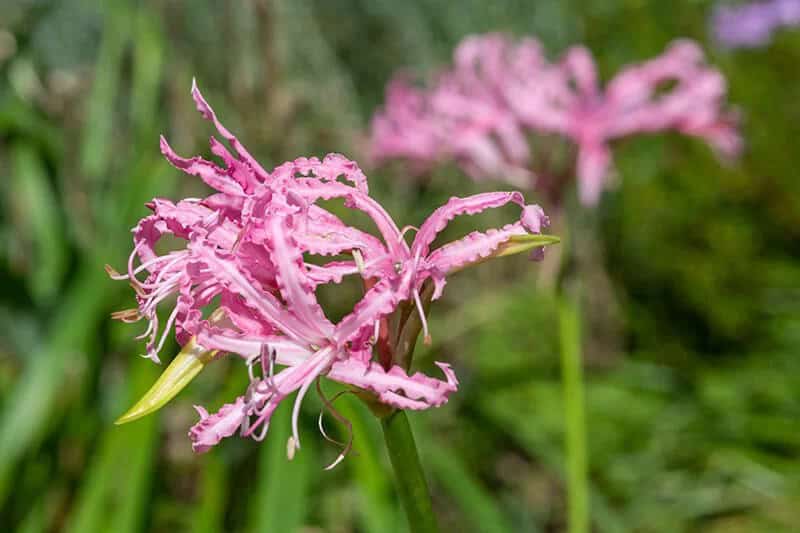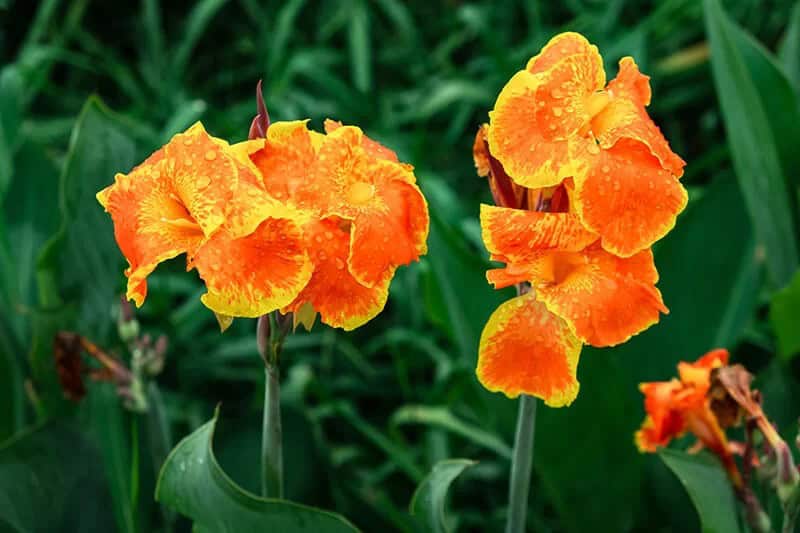For those seeking to bring a touch of the exotic into their indoor spaces without devoting hours to outdoor gardening, bulb flowers present an ideal solution. These adaptable plants thrive in indoor environments, boasting an extended blooming season and an impressive array of hues, forms, and dimensions to suit any décor.
27 Eye-catching Bulb Flowers for Every Garden
For those looking to inject a pop of color into their space without the commitment of plant care, these options offer an attractive solution. With minimal upkeep required, they’re ideal for busy individuals seeking a touch of greenery in their home or office setting. Their versatility is another major draw, allowing them to be utilized in various applications such as decorations, special events, and even everyday arrangements.
Grape Hyacinth (Muscari Aucheri)
Grape hyacinth, a perennial herbaceous plant in the grape family, boasts an impressive display of large, showy, bell-shaped flowers featuring a two-lipped corona that can range in color from blue to white and purple. Native to Europe and North Africa, this ornamental bulb flower has been introduced globally, thriving best in conditions that include full sun, average water needs that lean towards dry, and well-draining soil rich in organic matter.
Reaching up to 10 feet tall with leaves stretching 2 feet long, the annual flowering vine produces tubular flowers measuring 0.8 to 1.2 inches in length and 0.4 to 0.6 inches in width.
Emory Paul Dinner Plate Dahlia (Dinner Plate Dahlia Emory Paul)
The Emory Paul Dinner Plate Dahlia is a stunning flower that exudes elegance and dignity. This beautiful bloom requires average water intake, thriving in sandy, loamy, or acidic soil conditions. Its growing zones span from 2 to 10, making it adaptable to various environments. With full sun as its light requirement, the Emory Paul Dinner Plate Dahlia blooms mid-summer, showcasing its vibrant colors.
Created by Emory Paul through crossing the Dahlia with the African Violet in 1876, this flower is renowned for its breathtaking beauty and often referred to as ‘The Godfather of all Flowers.’ Reaching up to 8 inches in height, the dahlia comes in a diverse palette of white, yellow, red, blue, purple, and green hues.
Pheasant’s Eye (Narcissus Poeticus)
Daffodils, also known as narcissus poeticus, have been delighting people for thousands of years with their vibrant colors and sweet fragrance. These beloved flowers are steeped in symbolism, representing rebirth and renewal – a theme that resonates deeply across cultures. In ancient times, Daffodils were used to bring joy, hope, and happiness to those who witnessed them, often incorporated into rituals celebrating springtime, weddings, and funerals.
Today, they continue to brighten up gardens and homes around the world, requiring only low water needs, tolerating a variety of soil conditions, and thriving in zones 6 to 8. As the seasons change, Daffodils burst forth with late spring blooms, their beauty illuminated by the gentle winter sun for a brief but magical half-day period.
Crimson Flag (Hesperantha Coccinea)
In the realm of symbolism, the crimson flag holds a special significance – completion. This notion is deeply rooted in its essence, much like the plant’s ability to thrive in conditions that require average to high water levels and moist soil. In fact, it’s perfectly suited for growing zones ranging from 7 to 9, where it can bask in full sun to partial shade. The late summer blooming season only adds to its allure.
Native to South Africa and Namibia, the crimson flag is a perennial herbaceous plant that stems from a robust rootstock. Its slender, fleshy leaves and stems can grow up to 1 meter in height, giving rise to striking red flowers with five petals fused together at the base, forming a tube. The fruit is an 8-angled seedpod that measures up to 4.7 inches long and 1.6 inches wide, containing numerous small seeds adorned with wings that facilitate wind or water dispersal.
This ornamental plant has been cherished since its introduction into Europe in 1885, when it was hailed as a suitable alternative to Snapdragon (Antirrhinum majus). Its appeal lies not only in its striking appearance but also in the symbolism of completion it embodies.
Pickwick Dutch Crocus (Crocus Vernus Pickwick)
Crocus, a flower imbued with symbolism and medicinal properties, is a fascinating species to explore. With its connection to youth and rebirth, it’s no wonder that crocus has been a staple in traditional medicine for centuries. Its ability to thrive in average to dry soil conditions, well-draining soil, and full sun to partial shade makes it an attractive option for gardeners. In fact, this vibrant bloom is hardy enough to grow in zones 3 to 9, making it accessible to many regions.
When it comes to blooming season, crocus typically bursts forth in early spring, adding a pop of color to the otherwise barren landscape. But what’s truly remarkable about crocus is its rich history as a medicinal plant. Containing an array of antioxidants and anti-inflammatory properties, it has been used to treat wounds, skin diseases such as eczema and psoriasis, and even serve as an antiseptic in ancient times.
While its traditional uses have evolved over time, with people now appreciating it for its decorative value, the underlying symbolism and medicinal properties of crocus remain unchanged. With saffron crocus (Crocus sativus L.) being a specific species native to Iran and Afghanistan, it’s clear that this flower has played a significant role in cultural heritage and traditional medicine for centuries.
Spider Lily (Nerine Sarniensis)
Nerine, a herbaceous perennial plant native to temperate regions of Europe and the United Kingdom, boasts striking features. Its long, slender leaves typically display a green hue with vibrant red spots on their upper surface. The plant’s foliage is complemented by its impressive flowering stalks, which can grow up to 6 feet tall. These stalks support delicate blooms featuring white or pink petals, marked by a yellow base and accompanied by two prominent sepals at the flower’s base.
Nerine flowers typically bloom during late summer to early fall, thriving in conditions that favor average water intake, well-draining soil, and full sun to partial shade.
Meadow Blazing Star (Liatris Ligulistylus)
The Meadow Blazing Star (Liatris spicata) is a perennial plant that thrives in meadows and fields. Its botanical name is Liatris spicata, but it’s more commonly known as the Meadow Blazing Star due to its striking red flowers that bloom in late summer. The plant’s tall stem bears numerous flowers, making it stand out among other flora. Not only does this beauty catch the eye, but it also offers a range of benefits for local wildlife.
For instance, it provides sustenance for bees, birds, and butterflies, as well as creating habitats for other plants and animals to flourish. Its low water requirements, average soil needs, and ability to grow in zones 4 to 8 make it an attractive addition to any garden seeking a touch of nature’s splendor.
Sword Lily (Crocosmia Crocosmiiflora Lucifer)
Crocosmia, a genus of flowering plants within the Amaryllis family, comprises around 240 species. One of its most well-known types is the Sword Lily, characterized by sword-shaped flowers that can reach up to three feet in length. This perennial herbaceous plant, specifically the Sword Lily (Crocosmia crocosmiiflora Lucifer), is native to Europe and Asia, but has naturalized in North America and Australia.
Its adaptability allows it to thrive in a variety of habitats, including fields, forests, meadows, orchards, hedgerows, and areas near water sources. It requires average watering, tolerates sandy or loamy soil, and can be grown in USDA zones 5 to 9 under full sun to partial shade conditions, with blooming periods spanning from spring to fall.
Naked Lady (Amaryllis Belladonna)
The Naked Lady, a type of Amaryllis belladonna, can be found growing wild in various regions. This perennial plant produces a single, bare stem with leaves at the top, characteristic of its bulbous growth habit. With a rich history as an ornamental plant, it has been cultivated for centuries and is now commercially grown to supply bulbs used in the production of daffodils, narcissus, and other flowers.
Symbolism-wise, the Naked Lady embodies self-confidence and pride, while its growing requirements include average to dry water needs, dry to well-draining soil, a full sun to partial sun light exposure, and a thriving range of zones from 3 to 10. The plant’s blooming season typically occurs during mid-to-late summer.
Saffron Crocus (Crocus Sativus)
The Saffron Crocus, a flowering plant in the Crocus genus, is a staple in many cuisines worldwide. Native to Southwest Asia, it has been cultivated for thousands of years, prized for its vibrant yellow-orange hue and versatile flavor profile. The flowers are carefully dried and ground to produce saffron, a sought-after spice used to add depth and warmth to dishes like paella, risotto, rice pudding, soups, stews, and sauces.
This golden nectar can also be used as a natural dye, imbuing breads, desserts, yogurt drinks, and ice creams with its unmistakable color and aroma.
Peacock Orchid (Gladiolus Acidanthera)
The Peacock Orchid, a perennial plant native to tropical and subtropical regions of Asia, Africa, Australia, and the Americas, boasts stunning symbolism tied to beauty and dignity. This member of the lily family is characterized by leaves measuring 6-12 inches in length and 0.8-2.5 inches in width. Notably, the Peacock Orchid has been revered for its medicinal properties, including pain relief, stress reduction, appetite stimulation, and even treatment for epilepsy.
Its adaptability makes it an ideal choice for those seeking a low-maintenance yet eco-friendly addition to their space. With average water needs, a preference for sandy, loamy, or well-draining soil, and a growing zone range of 3-10, this plant thrives in full sun conditions, blooming majestically mid-summer.
Richard Wallace Canna Lily (Canna Richard Wallace)
The Richard Wallace Canna Lily is a unique hybrid flower renowned for its showy, fragrant blooms. Native to the United States, this cool-season plant has inherited characteristics from both the canna lily and the lily of the valley. Its striking purple petals feature subtle silver-white stripes. Created by American botanist and horticulturist Richard Wallace in 1885, this hybrid was first bred in 1884.
The blooms typically measure up to three inches wide and showcase a captivating pattern on the petals. These flowers are often white or cream-colored with pink or red tinges along their edges, thriving in conditions that require high water levels, loamy soil, and full sun exposure.
Guernsey Lily (Nerine Bowdenii)
The Guernsey Lily, also known as Jersey lily, is a perennial plant that falls under the genus Nerine. Its symbolism is rooted in freedom and good fortune, making it a popular choice for those seeking prosperity. In terms of its environmental needs, this plant thrives in average water conditions, loamy soil, and can be grown across zones 3 to 10. It requires full sun to partial shade to bloom, with the blooming season typically falling between summer months.
The plant’s flowers are predominantly white, but may also display pink or purple hues with purple markings on the petals, accompanied by occasional yellow spots. This bulb flower has been employed in herbal medicine for centuries, and is still utilized today as a folk remedy for various disorders, including diabetes, cancer, and arthritis. Its blooms typically arise from April to June.
Pink Rain Lily (Zephyranthes robusta Pink)

Zephyranthes robusta Pink, also known as pink rain lily, is a perennial plant native to South America but introduced to other countries. This type of flower is characterized by its long, tubular perianth tube that can reach up to 8 inches in length. The flowers themselves bloom in shades of pink and typically do so from mid to late summer, with the peak blooming period usually occurring between May and June.
The Zephyranthes robusta Pink plant grows up to 3 feet tall, featuring green leaves adorned with white spots that are arranged in opposite pairs on the stem. The flowers need an average to high amount of water, well-draining soil, and can thrive in growing zones ranging from 3 to 10. They also require full sun to partial shade.
Canna Lily (Canna Happy Cleo)
The Canna Lily is a rare sight in many gardens due to its unique characteristics. This annual plant can reach heights of up to 3 feet, producing small white flowers with striking purple stripes. Native to the tropical regions of Africa, Asia, and America, it’s often found in greenhouses rather than outdoor gardens.
Despite its uncommon presence, enthusiasts have successfully cultivated Canna Lilies by taking cuttings from parent plants or starting seedlings indoors and transplanting them outside when mature. With average to high water needs, a growing zone of 3-10, and full sun to partial shade, this plant requires specific conditions to thrive.
White Camassia Lily (Camassia Leichtlinii Alba)
The White Camassia Lily (Camassia leichtlinii) is a perennial native to eastern parts of the United States, characterized by its white flowers and affinity for moist, rich soils found in bogs and marshes. This plant’s symbolic significance is tied to purity, reflecting its pristine appearance and natural habitat. With high water needs, it thrives in zones 2 through 8, where it can receive full sun to partial shade. Its blooming season typically falls between late spring and early summer.
Notably, the genus name ‘Camassia’ originates from the Greek word for ‘beautiful’, coined by Carl Linnaeus in 1754.
Double Scarlet Begonia (Begonia Double Scarlet)
The Double Scarlet Begonia boasts a striking appearance, featuring vibrant red and white blooms. This begonia variety is an excellent choice for both indoor and outdoor spaces, offering versatility in terms of container or ground placement. To keep this plant thriving, it requires consistent watering to prevent drying out. Other growing conditions include average water needs, sandy to loamy soil, and a suitable range of 3-10 growing zones.
It also appreciates half sun exposure and blooms mid-summer.
Black Beauty Gladiolus (Gladiolus x Hortulanus ‘Black Beauty’)

Black Beauty Gladiolus (Gladiolus Black Beauty) is a captivating hybrid, born from the union of Gladiolus and the renowned ‘Black Beauty’ plant. This striking bulb flower boasts dark purple petals with a white background, offering a visually stunning display.
The creation of Alyssa Gartner, an artist and horticulturalist from New York City, this unique variety was designed to meet both the demands of gardeners seeking something new and exciting, as well as those who appreciate its inherent aesthetic appeal. In terms of growing conditions, Black Beauty Gladiolus requires average water intake, a sandy or loamy soil composition, and can thrive in zones ranging from 3 to 10.
It also needs full sun to partial sun exposure and blooms mid-summer, making it an ideal addition to any garden seeking a burst of color during this season.
Crown Imperial Yellow (Fritillaria Lutea)
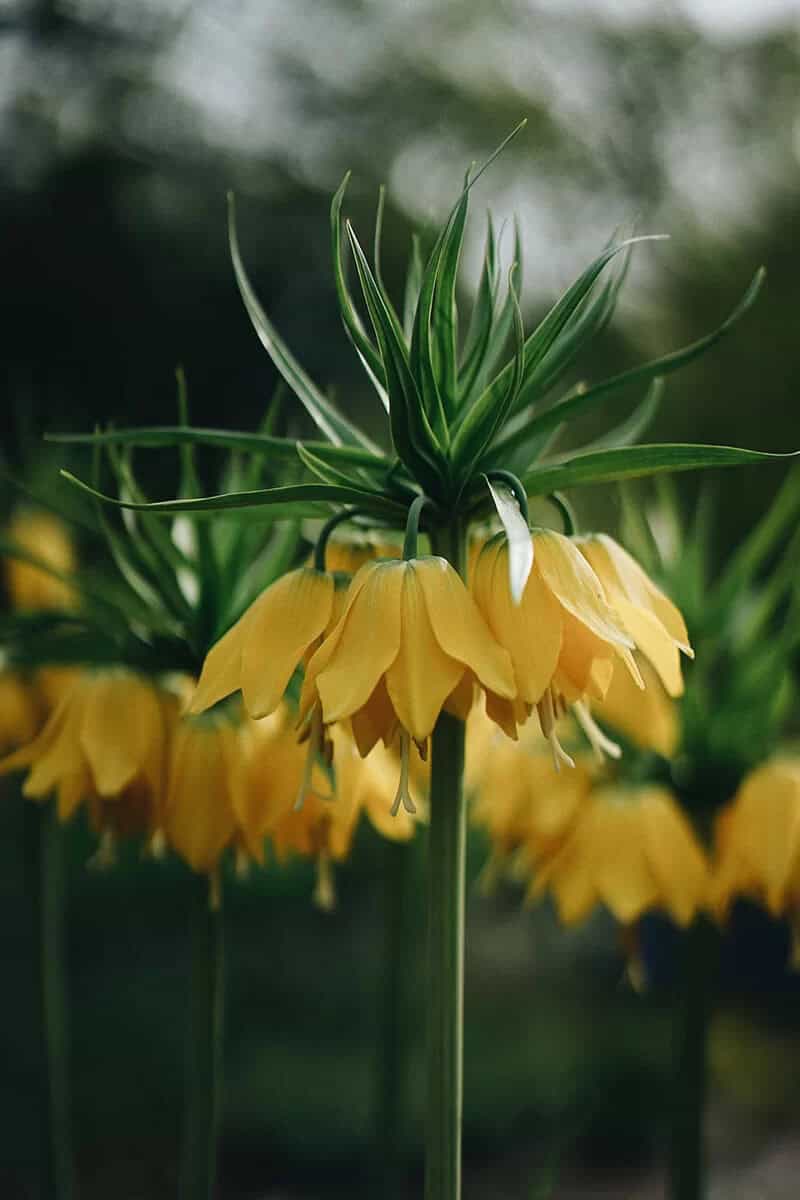
Crown Imperial Yellow, a type of fritillaria, is a spring-blooming perennial that thrives in conditions symbolic of royalty, power, and legitimacy. This plant’s impressive growth habit can reach heights of up to six feet, making it a striking addition to any wetland or water feature. Its bright yellow flowers with purple spots are often found in areas where the soil is loamy and receives full sun to half-day light.
Growing zones for this beauty range from 3 to 10, making it accessible to gardeners across North America. In China, Crown Imperial Yellow has been used medicinally to treat a range of issues, including stomach problems, dysentery, and inflammation, highlighting the plant’s rich cultural heritage.
Crocosmia Emberglow (Crocosmia Crocosmiiflora)
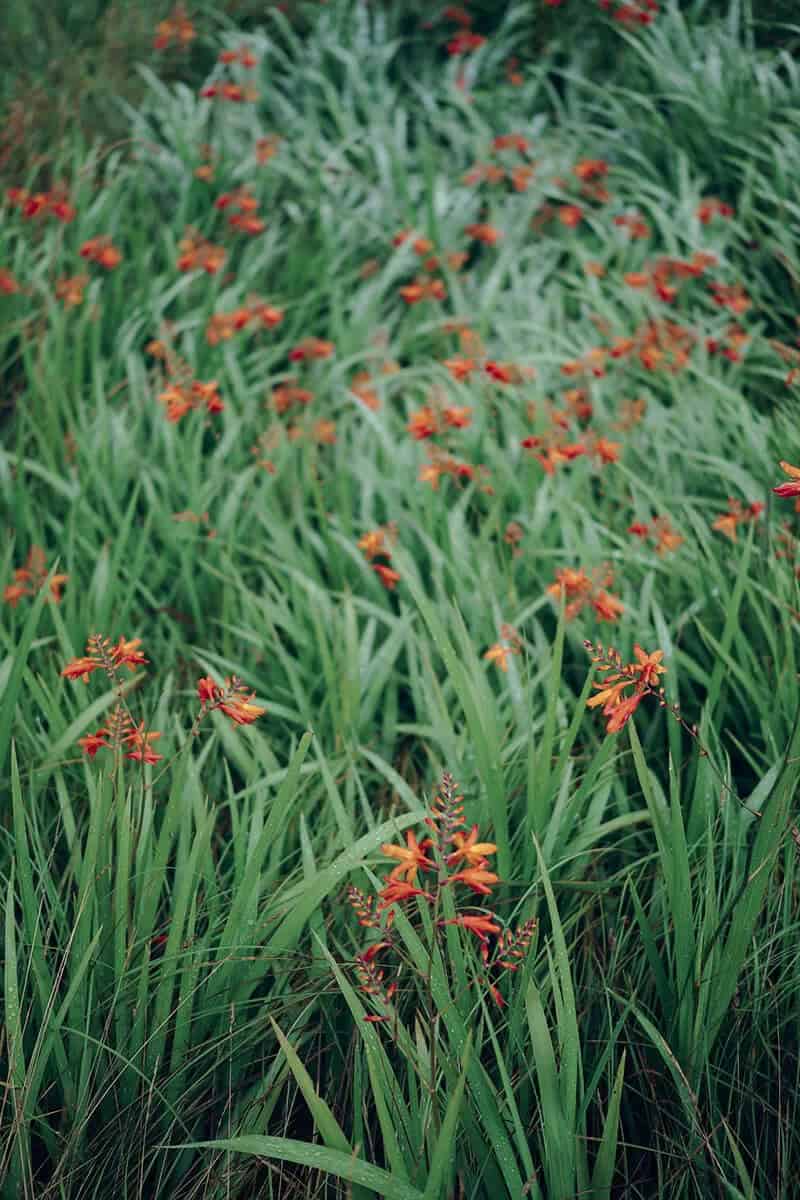
Crocosmias are stunning bulb flowers that thrive in temperate climates worldwide. These flowering plants boast vibrant blooms and foliage that can’t be missed. The Crocosmia Emberglow is a striking cultivar, characterized by its fiery orange hue. This unique variety was bred by crossing the Crocosmia Brilliant Star and Crocosmia Sunrise Surprise, resulting in an intense orange flower coloration. Symbolically, crocosmias are often associated with confidence, emotions of love, and deep feelings.
In terms of growing conditions, they require average water levels, preferring sandy or loamy soil. They can be found in zones 6 to 9 and thrive in full sun to partial sunlight. Blooming season typically occurs mid-to-late summer.
Stargazer Oriental Lily (Lilium Orientalis Stargazer)
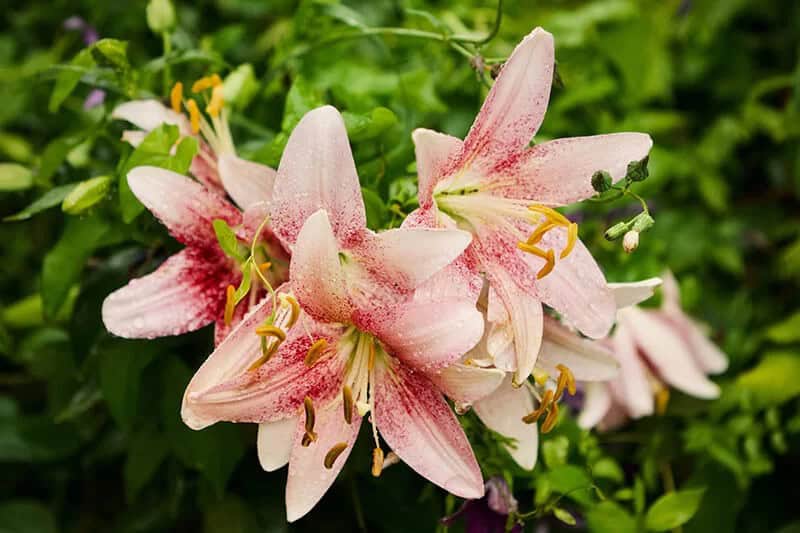
The Stargazer Oriental Lily (Lilium orientalis Stargazer) is a species of lily native to the temperate regions of central Asia, characterized by its unique behavior. The flower’s petals open in a star-like pattern at night, a phenomenon known as ‘stargazing’, and close during the day to avoid predators that might perceive it as a threat. This nocturnal habit has led to the name ‘Stargazer’ being aptly bestowed upon this species.
Not only is the Stargazer Oriental Lily used for ornamental purposes, but it’s also cultivated as a food crop in certain regions, such as China and Japan. Its low-maintenance requirements make it an attractive option for gardeners, who can plant it in pots or mix it into beds with ease. With its ability to thrive in average water conditions, loamy soil, and full sun to half sun, the Stargazer Oriental Lily is a versatile and hardy addition to any garden, blooming from mid to late summer.
Flowering Onion (Allium Giganteum)

The enigmatic Allium giganteum, also known as the Flowering Onion, boasts an onion-shaped flower head that blooms on long, slender stems. The delicate petals unfurl in shades of light purple, adding a touch of elegance to its unconventional appearance. This towering plant can reach heights of up to 10 feet, making it one of the tallest flowering plants globally.
This ancient species has been revered for centuries, with evidence of its cultivation dating back to ancient Egyptian times.
In this era, the Flowering Onion was employed as a symbol of eternal life, its unique blooms holding profound significance. The plant’s symbolism is multifaceted, representing good fortune, unity, and patience. When cultivated, it requires average to dry water levels, loamy soil, and full sun to half sun light conditions.
The Flowering Onion thrives in USDA growing zones 4 to 9, with its blooming season typically occurring late to early summer.
This rare plant is a true marvel of nature, offering a fascinating glimpse into the mysteries of the botanical world.
Tiger Flower (Tigridia Pavonia)
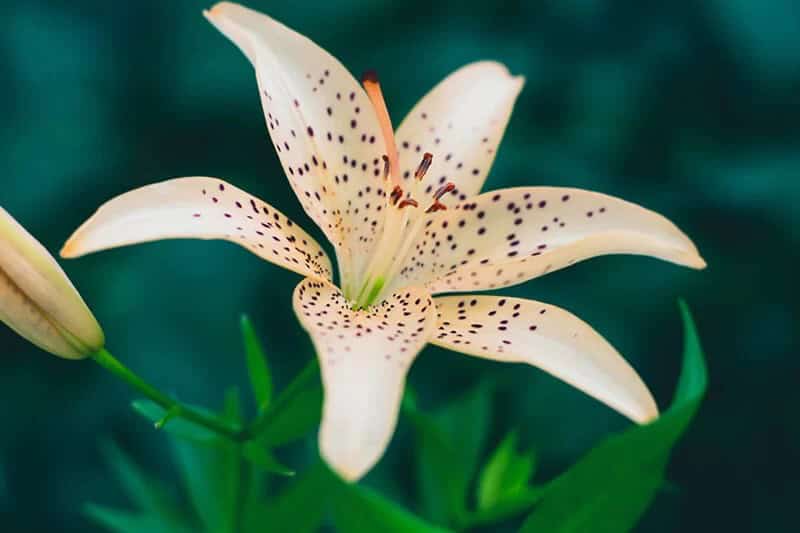
The Tigridia, also known as the Mexican Shelfllower, is a fascinating orchid native to Mexico. Its unique feature is that it grows on the underside of trees and rocks, much like a shelf. This plant has been gaining popularity in recent times due to its suitability as a houseplant. The Tiger Flower thrives under specific conditions – it requires average to dry water needs, sandy, loamy, or dry soil, and can be grown in zones 3 to 10.
It also needs full sun to partial sunlight and blooms during mid to late summer. With its striking appearance and interesting growing habits, the Tigridia is a plant that has caught the attention of many.
Peruvian Daffodil (Hymenocallis Festalis)
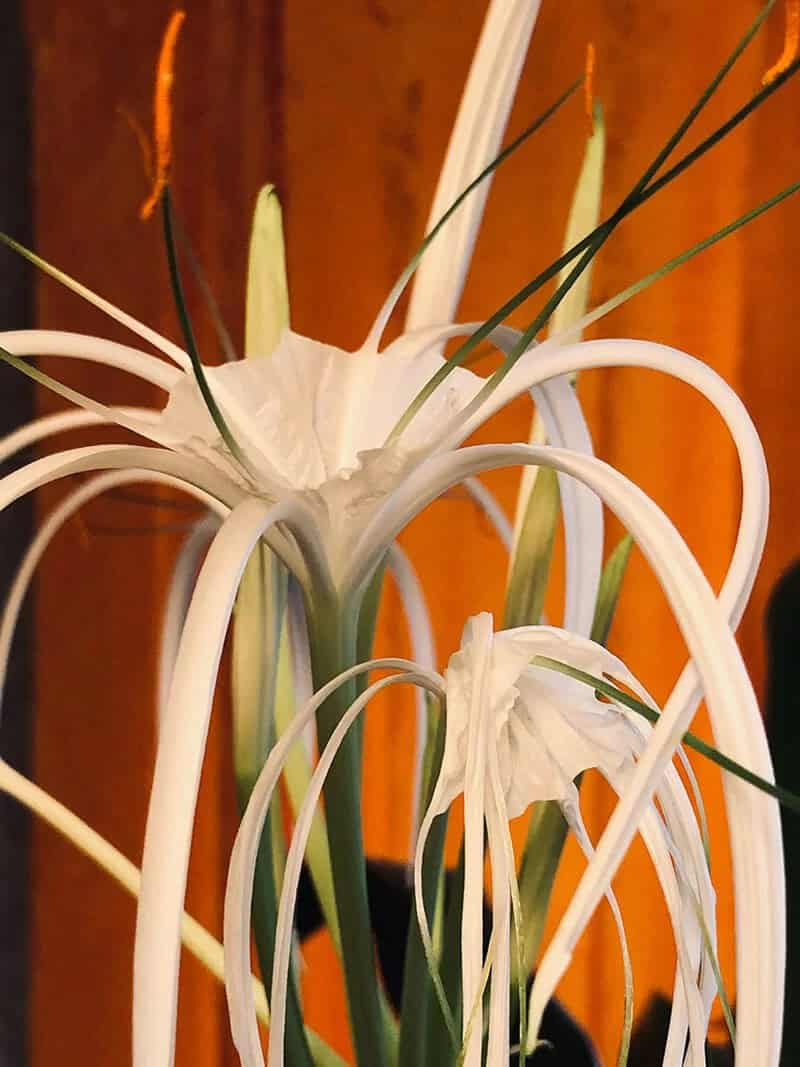
The Peruvian Daffodil, also known as the White Daffodil, is a stunning perennial bulbous herbaceous flowering plant belonging to the Amaryllis family, native to Peru. Its white petals are densely packed with pollen, creating a striking visual display when the flowers bloom in large quantities. This unique bloom pattern occurs from January to March, making it challenging to cultivate outside of its native habitat.
Despite these challenges, the Peruvian Daffodil remains an iconic symbol in Peru, with a rich history that predates the Inca Empire. Incan women, in particular, revered this flower for its natural properties, using it as a form of birth control or abortifacient. Today, it remains a cherished national treasure in Peru, celebrated for its beauty and cultural significance.
Care to Dance Bearded Iris (Iris Germanica ‘Care to Dance’)
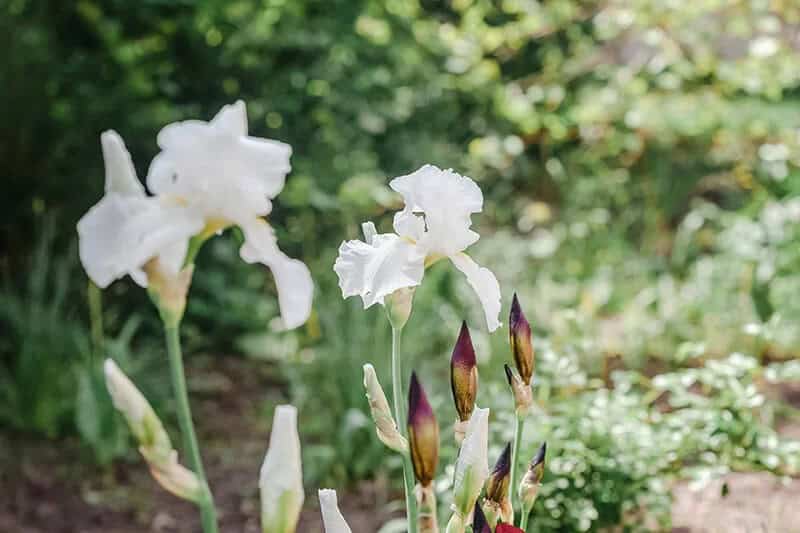
Iris germanica ‘Care to Dance’ is an annual plant that thrives in spring, boasting a striking combination of long, bearded stems and clusters of bright yellow flowers. The name ‘Care to Dance’ stems from the unique phenomenon where the plant appears to dance or move when its leaves or stems are touched by fingers or hands. This captivating quality has earned it the nickname ‘dancing iris’.
Native to Europe and Asia, this versatile plant can be found in temperate regions worldwide, thriving in areas with warm summers and moderate rainfall.
Nori Gladiolus (Gladiolus Nori)
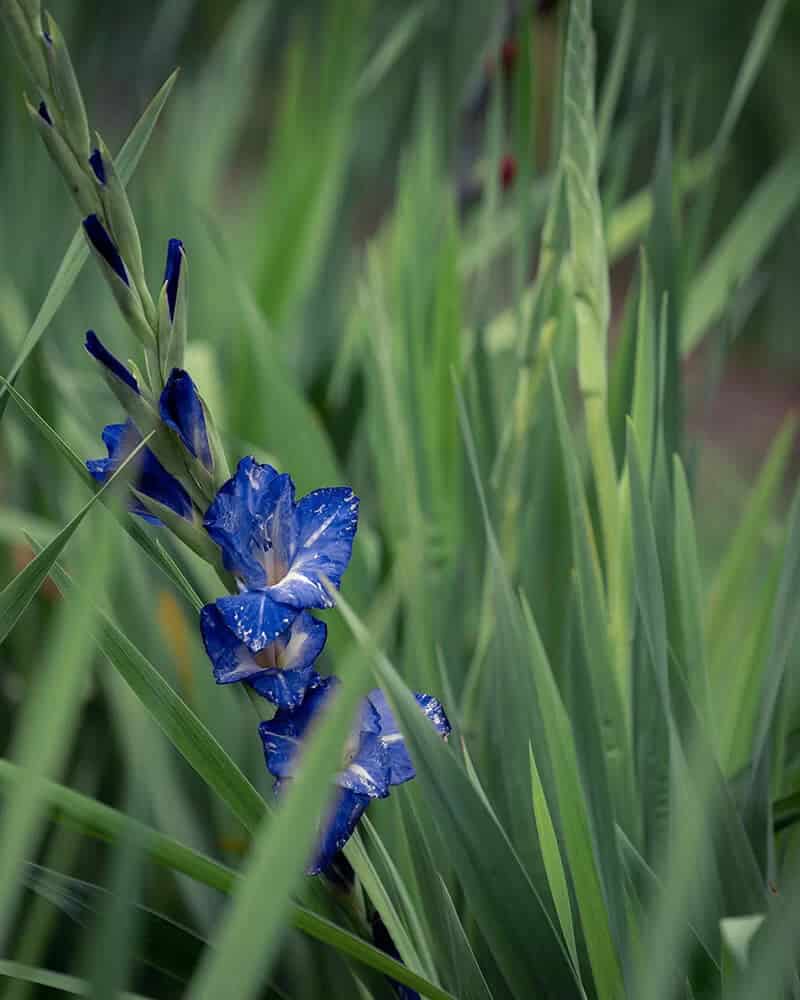
Gladiolus Nori, a Mediterranean native, has been delighting gardeners since its introduction to Europe in the late 1800s. Its stately blooms, often white or yellow, can also surprise with pink or purple hues. Measuring between six inches and two feet wide, some varieties even spread up to five feet across. Initially prized for its ornamental value in gardens and bouquets, Nori Gladiolus soon gained popularity as a statement piece due to its striking beauty.
Symbolically associated with strength and strong character, this plant thrives in average water conditions, preferring sandy or loamy soil. Growing zones 3-10 and full sun exposure ensure its optimal health. Blooming mid-summer, Nori Gladiolus is an excellent addition to any garden seeking a touch of elegance.
Orange Daylily (Hemerocallis Fulva)
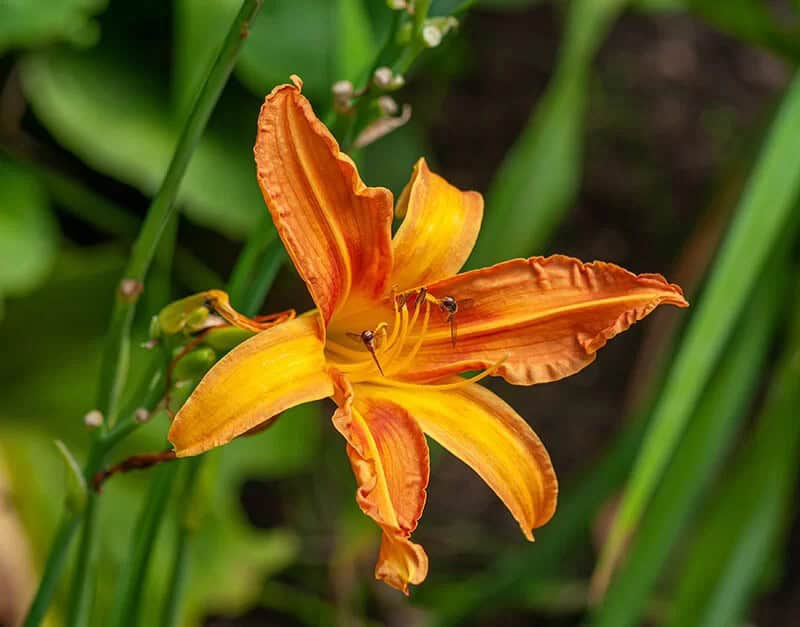
The Orange Daylily, a native North American plant, boasts vibrant orange flowers with a rich history of utilization. Its ornamental value is undeniable, while also serving as a source of sustenance. Historically, the flower has been employed for medicinal purposes, showcasing its multifaceted nature.
As a symbol of passion, this flowering perennial thrives in environments characterized by low water needs, loamy or clay soils that are dry to the touch.
Its hardiness allows it to flourish across growing zones 2 through 9, where it can bask in full sun to half sun conditions.
One of the flower’s most distinctive features is its potent scent, which draws in a variety of pollinators like bees, butterflies, and hummingbirds. With an early summer blooming season, the Orange Daylily is a beloved fixture in many North American landscapes.
27 Most Beautiful Types of Bulb Flowers
For those new to indoor planting, bulb flowers are an excellent choice. They require minimal maintenance, making them a great option for busy individuals who want to enjoy the beauty of plants without the commitment. What’s more, growing bulb flowers is a cost-effective way to add some color and life to your space. By only needing one type of plant, soil, and light source, you can create a lovely indoor garden without breaking the bank.
With minimal effort required on your part, you can enjoy the benefits of indoor planting without feeling overwhelmed.
